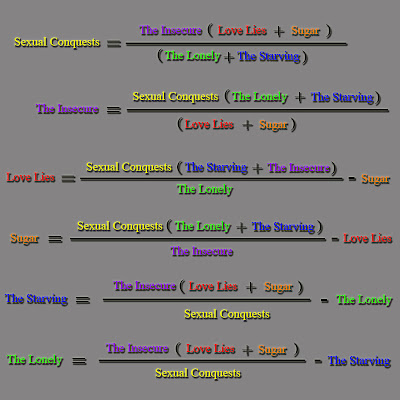The Expanded Similar Triangles Poem
The similar triangles method for constructing mathematical poems easily enables us to manipulate a logical structure for metaphoric expression. What this pedagogical blog entry is trying to accomplish is the introduction and showing of the expanded version of the similar triangles poem. This poetic structure is logically more complex however, still easy to manipulate.
Before you read further, please be familiar with the similar triangles poem. You may read about it here.
The 'regular' similar triangles poem only utilizes two similar triangles and is defined as an expression of two ratios. The expanded similar triangles poem utilizes ‘n’ number of ratios and is able to create very large (infinite) complex mathematical poems and still have a logical structure to act as a source domain for our metaphoric expression.
I am going to create an expanded similar triangle poem made of three similar triangles to serve as our example.
The following image shows three similar triangles with three different sets of relationships:‘a is to b’ as ‘c is to d’ and ‘e is to f’
 The trick in the construction of the poem is to add or subtract the numerators of two of the relationships and also add or subtract the two corresponding denominators of the same two relationships. The next image shows us how we construct our three ratios and associated them differently with subtraction and addition to form six flavors. There are actually 12 flavors possible however; I wish to focus on these six, which I consider the best ones to give us a good understanding of what is occurring in this method.
The trick in the construction of the poem is to add or subtract the numerators of two of the relationships and also add or subtract the two corresponding denominators of the same two relationships. The next image shows us how we construct our three ratios and associated them differently with subtraction and addition to form six flavors. There are actually 12 flavors possible however; I wish to focus on these six, which I consider the best ones to give us a good understanding of what is occurring in this method.
Each flavor yields a group of six equations after the flavor is solved for each variable. The next six images show the six syntactical arrangements for each flavor. There are at least seventy-two different syntactical arrangements however; I wish to focus on what I feel to be the thirty-six most important ones. The next six images show each of the six groups created by each flavor.
FLAVOR ONE YIELDS: FLAVOR TWO YIELDS:
FLAVOR TWO YIELDS: FLAVOR THREE YIELDS:
FLAVOR THREE YIELDS: FLAVOR FOUR YIELDS:
FLAVOR FOUR YIELDS: FLAVOR FIVE YIELDS:
FLAVOR FIVE YIELDS: FLAVOR SIX YIELDS:
FLAVOR SIX YIELDS: Lets now create a poem using the following text.
Lets now create a poem using the following text.
a = Love Lies
b = The Lonely
d = Sugar
e = The Starving
g = Sexual Conquests
h = The Insecure
The structure follows as thus: ‘Love Lies’ is to ‘The Lonely’ as ‘Sugar’ is to ‘The Starving’ as ‘Sexual Conquests’ are to ‘The Insecure’
We then substitute the variables with the poetic phrases to yield thirty-six poems in six groups relating back to the flavors shown above.
I find it interesting to savor each syntactical permutation to get a ‘feel’ for each poetic expression.
GROUP ONE CONSTRUCTED FROM FLAVOR ONE: GROUP TWO CONSTRUCTED FROM FLAVOR TWO:
GROUP TWO CONSTRUCTED FROM FLAVOR TWO: GROUP THREE CONSTRUCTED FROM FLAVOR THREE:
GROUP THREE CONSTRUCTED FROM FLAVOR THREE: GROUP FOUR CONSTRUCTED FROM FLAVOR FOUR:
GROUP FOUR CONSTRUCTED FROM FLAVOR FOUR: GROUP FIVE CONSTRUCTED FROM FLAVOR FIVE:
GROUP FIVE CONSTRUCTED FROM FLAVOR FIVE: GROUP SIX CONSTRUCTED FROM FLAVOR SIX:
GROUP SIX CONSTRUCTED FROM FLAVOR SIX:
Many of the links below are examples of the expanded similar triangles poem.




2 comments:
Definitely beautiful! Could I please copy an image of the mathematical poems on this blog and publish it on my blog - with references to you, of course?
I did'nt know mathematical poems untill now! Wonderful!
Thank you so much for your warm comments ... be my guest take what you want.
Thanks,
Kaz
Post a Comment